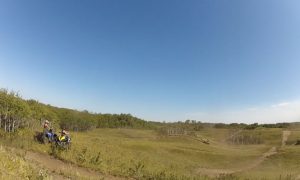Partnering for the future of ATVing
ATVMB and SATVA have started collaborating in order to better serve their members
RIDERSWEST
by Karen Kornelsen |

Manitoba and Saskatchewan have a lot in common, including terrain.— Photo courtesy Con Huberdeau
Manitoba and Saskatchewan have a lot in common, especially when it comes to ATVing. The similarities in the challenges they face and the resources they have are part of the reason the Saskatchewan All Terrain Vehicle Association (SATVA) and ATV Association of Manitoba (ATVMB) decided it was time they work together.
The idea originally formulated in 2015 at the Power Up and Beyond conference held in Toronto, according to Kim Wozniak, ATVMB manager. She and John Meed, SATVA general manager, had a discussion about the similarities between their two organizations and common issues they both face.
“John later suggested that we may be able to learn from one another by sharing our successes and any issues we may face and the best way to do that would be by having a representative from each federation serve in a non-voting capacity on our respective boards,” said Wozniak. “This idea was presented to the ATVMB board of directors who embraced it, feeling that this partnership would be beneficial to both organizations.”
According to Meed, of all the jurisdictions in Canada, Saskatchewan and Manitoba closely align with certain challenges.
Facing the challenges
“Right now, neither of us are getting a tremendous amount of government support, which is one of the real issues we need to overcome,” said Meed. “Support can come in a lot of ways including financially but it also mean support in creating opportunities to develop trails and steward existing trails within provincial forests.”
The two organizations also have issues with resources, with both organizations only having one part-time staff person. They also have roughly the same number of clubs.
“With the two organizations working together, there is definitely strength in numbers,” said Meed.
A provincial partnership
There are a few ways SATVA and ATVMB plan to work together, on top of having a representative attending the other’s board meetings. In the future, a joint board meeting may be held. They’re also playing with the idea of having a trail-building workshop.
“One of the problems we have is the lack of expertise in our area as far as developing and putting together the groundwork to get the support and resources to even start working on a trail,” said Meed. “We collaborated with the provincial government on one trail this past year and that proved to be pretty beneficial. If we did a workshop, we think certain interest groups would also see the benefit and it’d be great to develop best practices in trying to develop a trail system within an area.”
“Sharing of knowledge and expertise in areas where one group excels over the other will contribute to the overall success of an organization,” Wozniak said. “In addition to our individual partnership with SATVA, our connection with the All Terrain Quad Council of Canada (AQCC) expands on that and gives us the opportunity to connect with other similar federations who face similar challenges. Identifying these challenges nationally allows AQCC to better serve those federations by being able to deliver solutions that can work across provincial borders.”
The national scene
The AQCC held its annual general meeting in Halifax in September and both Wozniak and Meed were in attendance.
“One of the big benefits of the AGM is collaboration,” said Meed. “It’s great having all the provincial jurisdictions there and have discussion on what each one is facing. I think the AQCC is also wanting to be more receptive and focused on helping the provincial federations thrive and be more productive. One of the things that came out of the conference was to start rethinking the strategic plan for the organization and how they can help the provincial federations do what they need to do at a federal level.”
For Wozniak, this was her first AQCC and she said she found it quite interesting.
“AQCC is a fairly young organization as far as national organizations go and they are working on how best to serve all ATV federations in Canada,” she said. “Attending the conference reconfirmed that having a national voice is important and beneficial to our provincial endeavours. I came away from the conference with an interest in assisting AQCC to the best of my ability to ensure that ATV federations across Canada thrive. We all have challenges in our respective provinces and strengthening our national organization will also strengthen the provincial federations.”
Going forward, both SATVA and ATVMB are looking forward to more collaboration in 2017 and are excited to grow the partnership even further.
